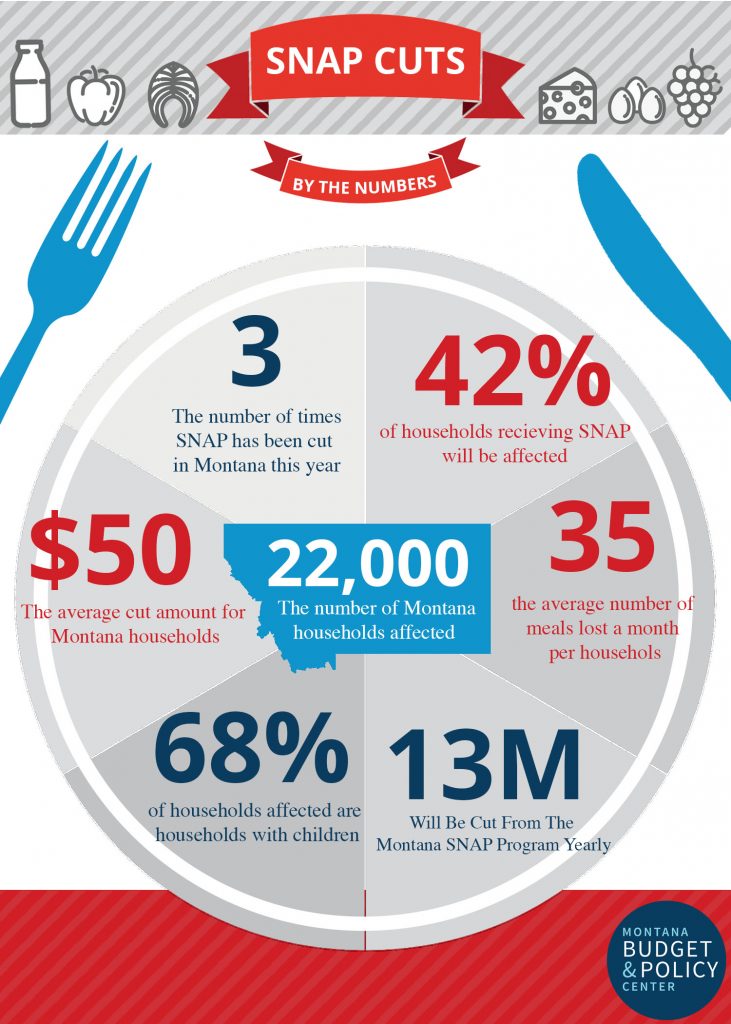The Trump administration announced yet another enormous cut to SNAP this past month.
This latest attack cuts $4.5 billion from one of the nation’s most successful anti-hunger and anti-poverty program over the next five years. Coming on the heels of other proposed cuts earlier this year, this cut is significant in its own right. The effect on SNAP recipients in Montana, however, will be staggering.
The proposed rule change deals with the way states calculate their Standard Utility Allowances (SUAs), a factor used in determining SNAP benefits. Under the current proposal, 42 percent of SNAP households in Montana would see an average cut of $50 a month. Montana will lose $13 million a year in SNAP funds, an 8 percent loss. Out of all the states affected by this rule change, Montana is one of the hardest hit.

What is the Standard Utility Allowance?
The Standard Utility Allowance (SUA) is used in calculating SNAP benefits. Benefits are determined using a formula that considers a household’s net income, expenses, and what the USDA estimates a household of that size needs to spend on food.
A household’s net income is determined by subtracting certain deductions from a family’s gross income, including:
The Standard Utility Allowance is used to calculate the excess shelter deduction, which determines the household’s net income.
The net income determines the amount of benefits a household will receive. A household is expected to use 30 percent of their net income on food. The monthly benefit is determined by subtracting this expected contribution from the maximum benefit for their household size. If the SUA is lowered, the net income calculated will be larger and the benefit received will be smaller.
Rather than asking households to provide months’ worth of bills which may vary greatly, each state is allowed to set its own SUA. The standard is purposefully set high in order to capture all households’ utility costs and account for fluctuations.
What does the rule change do?
Under the proposed rule change, the federal government will have the authority to determine how states calculate their SUA. The proposed methodology, however, sets SUAs at a significantly lower threshold for many states.
In 2017, Montana’s current SUA was $520. The Trump administration has proposed lowering the SUA by 36 percent, down to just $334. This lower SUA will mean when a households’ benefits are calculated, they will receive less in SNAP benefits.
Some states which previously had lower SUAs will see an increase in benefits, however, overall this rule change will cut $4.5 billion from SNAP in 5 years.
Who is affected?
In Montana, over 22,000 households (42 percent of those participating in SNAP) will be affected by this rule change. And the cut is large – affected households will receive $50 less a month. The average household affected by this cut receives $228 a month in SNAP benefits, making this a 22 percent cut in benefits – almost an entire week’s worth of food. With the average SNAP benefit being just $1.40 per meal, this cut is the equivalent of taking 35 meals off the table.
Nationwide, 19 percent of SNAP households will receive lower monthly benefits.
The elderly and people with disabilities are most affected by this cut. The average benefit loss is greater for seniors and people with disabilities, according to the USDA’s Regulatory Impact Analysis. Because there is no cap on excess shelter deductions for households with senior or disabled members, a lower SUA will mean a greater loss in benefits.
Nationwide, 26 percent of SNAP households with an elderly member will lose benefits, as will 30 percent of households with a disabled member. Children will also lose benefits under this cut – 68 percent of the affected households will be households with children.
But a $13 million loss to the state in SNAP benefits each year will harm more than just SNAP households. This loss to the economy will also hurt local businesses, grocery stores, and farmers. It will create increased pressure on food banks, and result in greater food insecurity throughout the state.
What can be done?
The USDA is accepting comments on this rule change until December 2nd. If you or your organization would like to leave a comment about the impact this rule change would have on Montana’s children, elderly, and people with disabilities, or its affect on our economy, please do so through the federal register.

MBPC is a nonprofit organization focused on providing credible and timely research and analysis on budget, tax, and economic issues that impact low- and moderate-income Montana families.